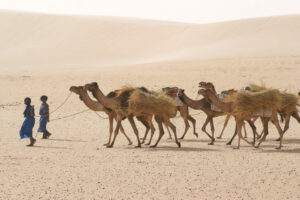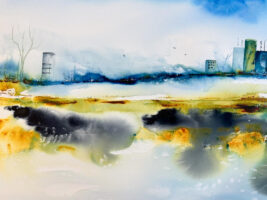Support Hidden Compass
Our articles are crafted by humans (not generative AI). Support Team Human with a contribution!
Ali and I laid on our backs, hands cupping our heads, counting meteors as they arced across the star-filled sky. In the stifling heat of the Malian summer we had spread our mats on the baked clay roof of Ali’s home and spent the evening drinking sweet tea while he told me ancient stories by the glow of an oil lamp. His skin was so dark that at night, all I could see were teeth and eyes, but both always seemed to be smiling.
Days earlier, I had found Ali by chance among the hysterical mob of taxi drivers that assailed travelers at Bamako’s international airport. Why did I choose Ali? Because he was the only one wearing the traditional three-cornered Dogon hat; nothing more. It was a traveler’s roll of the dice, and he was a good choice.
Ali was not only of a different place, but of a different time, and I was desperately in need of time away from my own. He was a natural talker, but with a soothing voice honed by his profession as a guide. One evening, when I was not yet ready for esoteric truths, he pointed skyward and said, “That is where I come from.”
I had gone to Mali to hear such words without ever really expecting to. Most tribal societies have a “tourist” creation myth — if they are open to outsiders at all. I knew that the Dogon claimed one of the oldest, richest, and most complex cosmologies that some believe involves space travel. Somehow, the Dogon seem to have possessed knowledge about our universe centuries before such information could be verified by modern telescopes.
Such a story had to be followed.
~~
The red cliff mesas and spiraling rock walls of Southern Mali’s Bandiagara Escarpment are an other-worldly moonscape: biblically old and primeval in appearance. It is a desert of undefined power and beauty, a land of phenomena so alien to outsiders that it is hard for Western minds to comprehend. To enter it, one must surrender to both the wonders and terrors of the ancestral home of the Dogon.
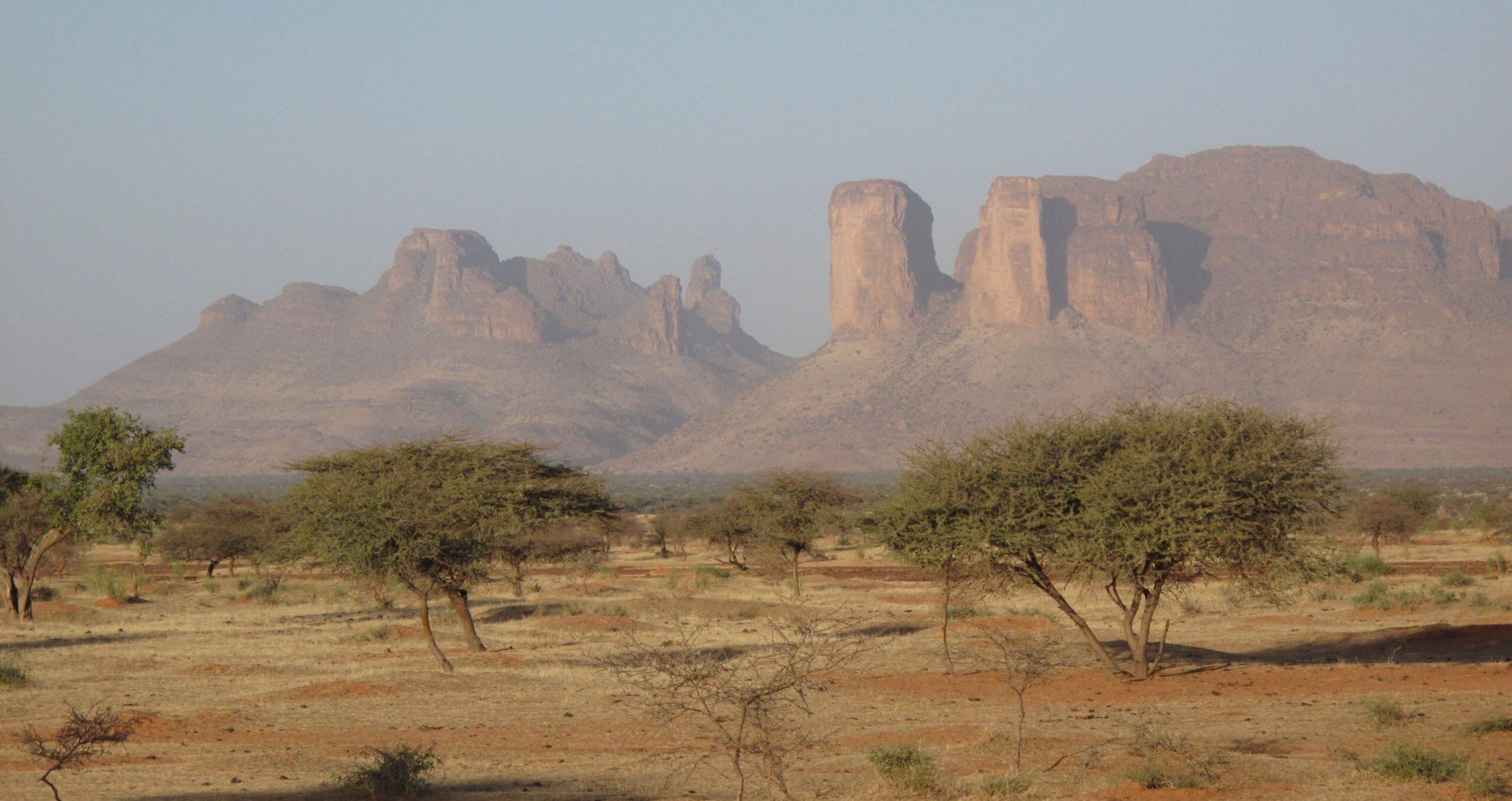
The Bandiagara Escarpment in Mali rises approximately 500 meters above the sand flats below and stretches for 150 kilometers. It is home to the Dogon people. PHOTO: AFRIPICS.COM/ALAMY
With Ali, I go where few visitors have gone. We visit bloody stones where boys lose their foreskins on the path to manhood, and we silently enter secret caves, forbidden to women, where warriors gather to eat meat. At an ancient rock wall, sheared centuries ago by lightning, we are overwhelmed by the brilliant ochre, black, and white primordial designs painted by hands that have left fingerprints behind. Later, from deep inside an impossibly dark cave, Ali produces ceremonial instruments secreted in a wall crevasse. But despite all these revealed secrets, there’s something else I’m hoping to learn.
~~
Our journey began in one of the Dogon’s main commercial settlements of Niangomo, a regular stop for visitors who pay to see staged dances in imitation traditional headdresses. But, as we ranged further afield, the land and people turned feral and real. At two of the most remote sites, hidden voices challenged us, echoing throughout the valley, and our approach was met with a hail of hurled stones that caused me no shame in making a swift retreat.
Centuries ago, the Dogon adopted vertical architecture to avoid the attention of other unwanted trespassers — slavers. They took to building mud cities in giant, sheer, sandstone caves carved by centuries of wind and water, or on impossibly steep hills, beyond the reach of invaders. Because their homes are made of and from the earth, cities housing thousands blend effortlessly with the barren land, all but invisible from a short distance, hiding in plain sight. They say it has been so for more than 1,000 years.
To my Western eyes, their cities bore great similarities to those of the Anasazi of the American Southwest, particularly with the Taos Pueblo. When I mentioned this to Ali, he suggested that perhaps his ancestors had visited there on one of their journeys to the Dog Star.
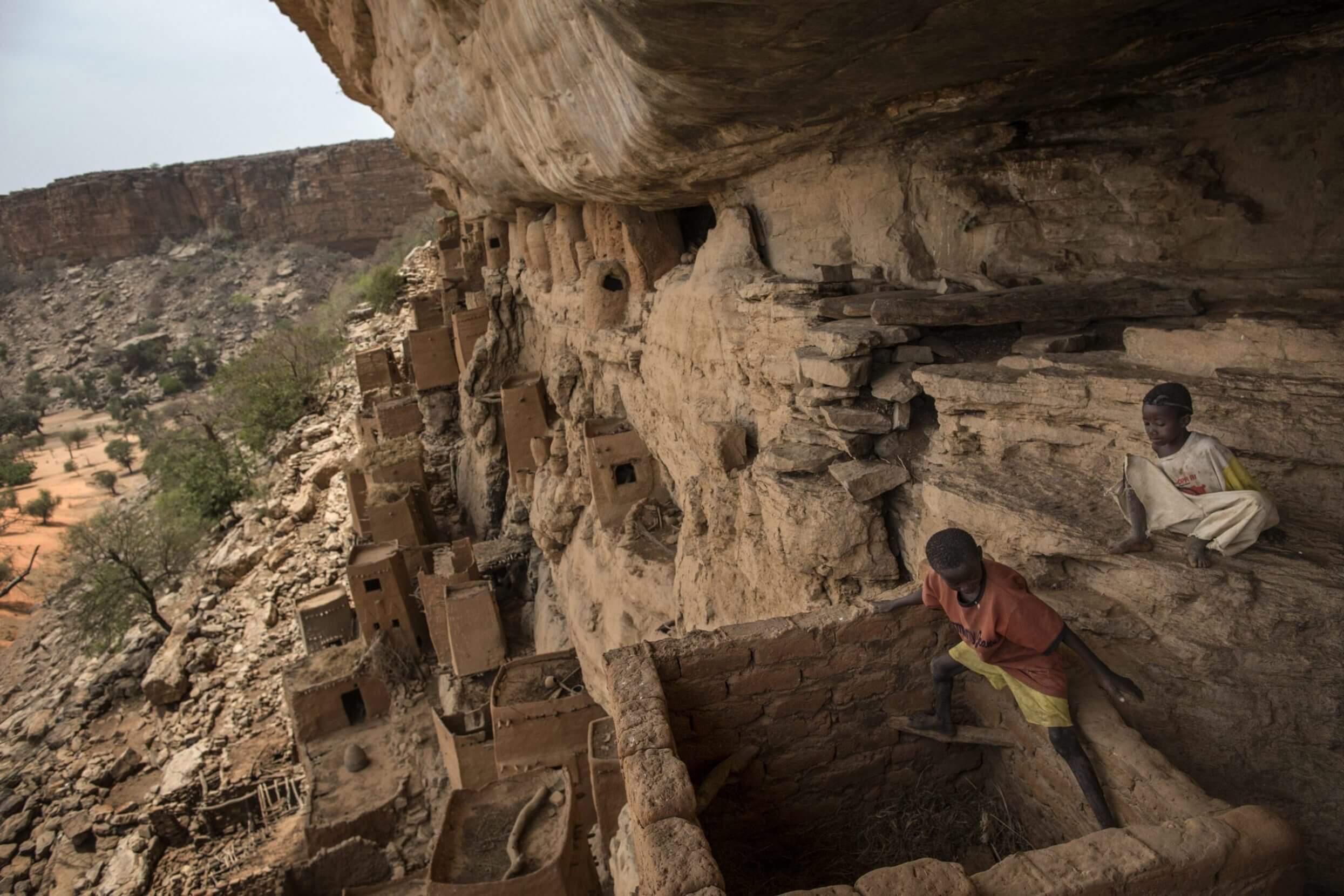
To hide from slavers and others, the Dogon people began building their towns vertically into the sheer cliffs of the Bandiagara Escarpment. PHOTO: MARCO DORMINO/UN PHOTO
~~
The way I understand it, archeological evidence suggests that these “Children of the Dog Star,” as they call themselves, arrived between the 11th and 13th centuries. They most likely came from Egypt, as there are key words and meanings in their language eerily linked to similar pronunciations in ancient Egyptian, besides current ceremonies known to also have been practiced in ancient Egypt.
At the same time, there is a heavy influence from Judaism, which traveled south into the Sahel of Timbuktu, carried by camel caravans from Jewish merchants in the north: The Dogon practice circumcision, have a jubilee year, and often wear skull caps and prayer shawls during ceremonies. Even the traditional Dogon three-cornered hat shares characteristics with Jewish side locks. Such blending of faiths is not uncommon on Africa’s western shores. It is a land dominated by voodoo, that has spawned many belief systems while mixing desert superstition with ritual and ceremony.
But there is much more to the story. The Dogon claim a different origin, and if the Dogon have traveled from another planet as they claim, they most assuredly could have made a few stops along the way — like Taos.

Dogon cliff dwellings are seen on the Bandiagara Escarpment in Teli, in the central region of Mali. The escarpment was listed as a UNESCO World Heritage site in 1989. To author James Michael Dorsey, the dwellings strongly resembler those of the Anasazi found in the U.S. Southwest. PHOTO: MARCO DORMINO/UN PHOTO
~~
As days passed and our ease in each-others company grew, I still treaded lightly, struggling not to ask about the Dogon creation legend. I did not want to cross some cultural line before earning Ali’s trust fully. Normally my advanced age and white hair opens doors for me in such remote places, as I am usually older than anyone in the village and age is respected in tribal areas. Locals automatically refer to me as “papa,” a handle that Hemingway once carried and that I am also proud to lay claim to; but with Ali, age meant nothing.
The mystery remains, and truth seekers such as myself are still drawn to this land that is coated with mysticism.
The Western world was first introduced to Dogon cosmology nearly a century ago, when anthropologist Marcel Griaule and his associate, Germaine Dieterlen, spent three decades living among them. They recorded the Dogon’s oral histories and legends, and documented them in a series of books that linked the Dogon to a distant planet. But Griaule’s research was based primarily on conversations with a single blind elder named Ogatomelli. Those conversations fueled the imaginative fires of a science fiction writer named Robert Temple, whose wishful, best-selling books about these alleged space-traveling aliens spawned a wave of speculative theories about how we are not alone in the universe.
Many believed the Dogon legends were influenced by the European researchers themselves. Other anthropologists suggested that the stories of Ogatomelli were an old man’s attempt to ward off an invasion of intruders. Ironically, the legends brought in an influx of those wishing for enlightenment — in all its forms. In the drug-induced haze of the ‘60s, suddenly the Bandiagara Escarpment became a destination on par with Kathmandu and Marrakesh.
Today, the trippers and the hippies are long gone. But the mystery remains, and truth seekers such as myself are still drawn to this land that is coated with mysticism.
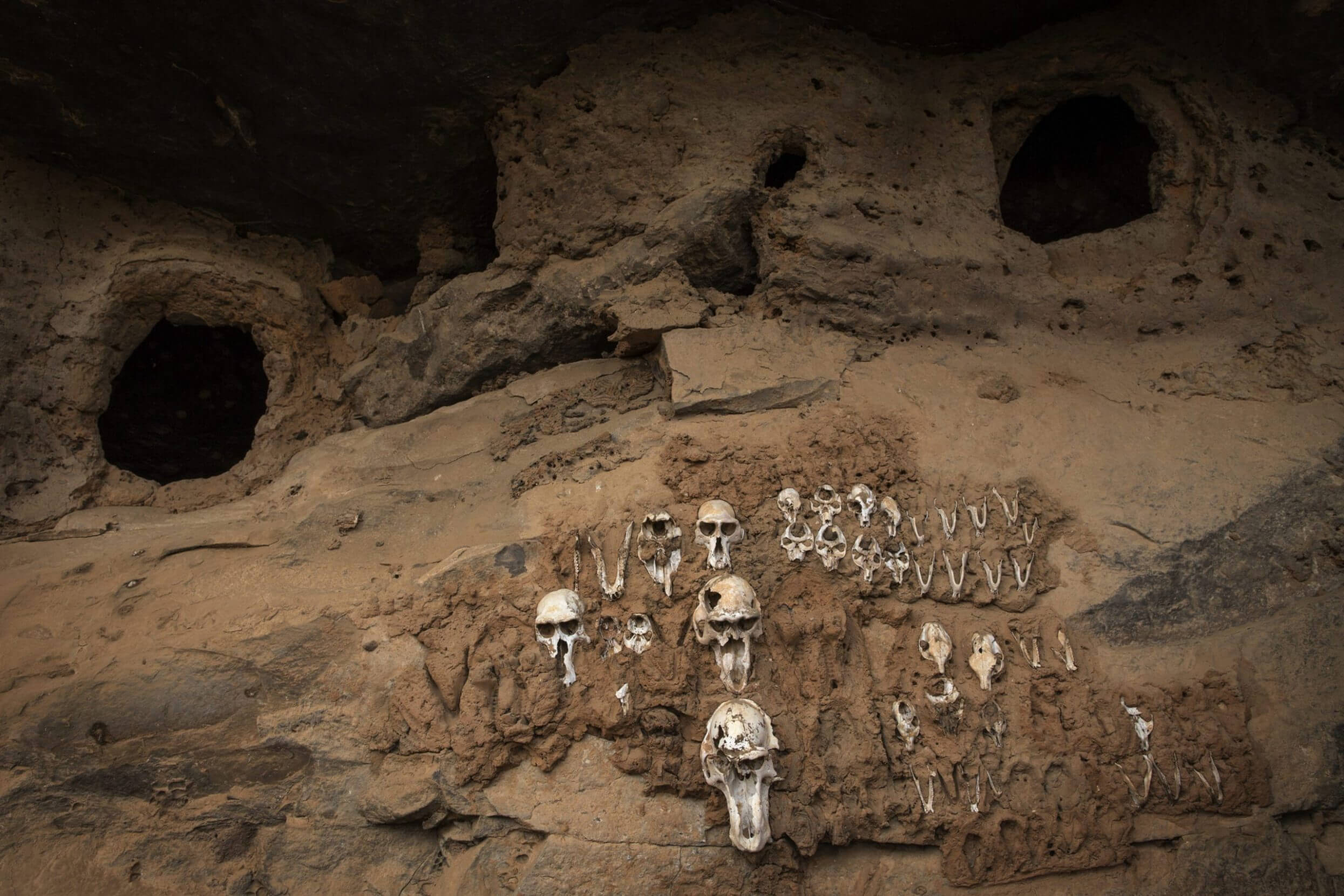
Monkey skulls are seen outside a home on the Bandiagara Escarpment In the Dogon religion, the skulls are believed to protect the inhabitants of the escarpment from wild animals. PHOTO: MARCO DORMINO/UN PHOTO
~~
A lazily rising crescent moon turns from orange to white, casting ethereal shadows across our rooftop. I watch cooking fires dance like candles inside pumpkins, illuminating ageless houses tucked into the sides of cliffs. Panting in the relentless heat, I search the infinite sky for the Dog Star that the Dogon claim as their ancestral home. Following a line through Orion’s belt, I think I’ve spotted it and hope for a personal connection. It’s only moments later that Ali points skyward, indicating that he is willing to share the stories I have hoped to hear. Ali opens the door to what might be one of the oldest creation tales on earth.
~~
Since earliest man, we have sought reasons to believe in something higher, something to give our temporary lives meaning. Tonight, as we lay on the rooftop of his home, Ali speaks as one who has been there at the beginning of creation as according to him, all Dogons were. To Ali, the past, present, and future are all one. Then is now, and we were, and are, present at our own creation.
While Ali’s appearance does not change, the way I see him does. He begins to speak of a race of amphibious, snake-like creatures that resemble mermaids and mermen, calling them “Nommos,” and as he does so, he becomes a slithering, dancing reptile in a boneless body. I am told their home is a planet in the star system of Sirius, home of the so-called “Dog Star” because if you draw a line linking the points of the nearby stars, it supposedly resembles a dog.
At this moment, my companion is no longer Ali. He is in a trance-like state, and I believe he is receiving information from another source.
Many of the Dogons’ celestial observations of planets and their orbits have indeed been verified by science.
Only once does he pause for breath, eyes rolling back in his head, then he continues urgently, using body language and intonation to convey nuances that I am hard put to follow. The story as he tells it is both dance and ceremony:
According to Ali, Nommos came to earth in an “arc” to create the Dogon as first man. These beings came from the brightest point in the sky, what Westerners call Sirius. The Nommos revealed that Sirius was not a single star system. They believed that another, smaller star — known to them as “Po Tolo” — circled the larger one in a 50-year elliptical orbit. The Nommos carried with them great wisdom: that Po Tolo rotates on its axis and is composed of unusually dense matter; that Jupiter has four moons; Saturn has rings; and that planets of our solar system orbit the sun. Of course, they did not use those planetary names.
None of this should have been known by an ancient people with no technical apparatuses. Our understanding of planetary motion wasn’t solidified in the West until after the invention of the telescope and a series of breakthroughs in 17th-century physics. A smaller star of the Sirius system, now known to the Western world as Sirius B, was assumed to exist for over a century but only conclusively verified in 1970 when photographed through a powerful telescope.
Although Dogon mythology has been the subject of much skepticism, could it be that cries of fabrication are symptoms of a Western bias unable to fathom or accept a wisdom that predates our own?
Despite the improbability of knowing such precise astronomical information in such an early era, many of the Dogons’ celestial observations of planets and their orbits have indeed been verified by science. Galileo invented the telescope in 1609. Dogon oral history can be traced back through almost 6,000 years of archeology.
Or so it is said.
~~
When Ali finished his story, he took my hand and smiled, and I felt totally insignificant.
Then questions poured out of me: Do the Nommos still exist? How often do the Dogon return to Sirius? How do they travel there? Do they fly on their own or use machines?
Ali listened with an amused smile to all of it and then quietly said, “You are not a Dogon.” He had told me his story and would say no more.
~~
Since that journey I have often spent nights in my backyard searching for the Dog Star. I try to imagine Ali shuttling back and forth, perhaps as a beam of light or maybe a spirit.
Maybe the Dogons have retained an ancient mystical ability that has gone vestigial in the rest of us. Maybe we are meant to continue the journey, searching for answers that may not exist.
Or maybe the answers do exist, and we are simply not meant to know them.
James Michael Dorsey
James Michael Dorsey is an award-winning author, and explorer, who has spent decades documenting vanishing cultures in Africa and Asia.


